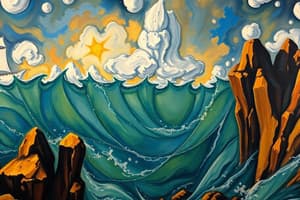Podcast
Questions and Answers
What occurs at the mid-ocean ridge during seafloor spreading?
What occurs at the mid-ocean ridge during seafloor spreading?
- Sediment accumulates
- Oceanic plates collide
- Land masses are formed
- Molten material rises from the mantle (correct)
The magnetic stripes created by seafloor spreading are uniform in width regardless of the stability of the Earth's magnetic field.
The magnetic stripes created by seafloor spreading are uniform in width regardless of the stability of the Earth's magnetic field.
False (B)
What phenomenon causes the newly formed rock at the mid-ocean ridge to align with the Earth's magnetic field?
What phenomenon causes the newly formed rock at the mid-ocean ridge to align with the Earth's magnetic field?
Cooling and solidification of molten material
The patterns of alternating magnetic stripes on either side of the mid-ocean ridge are a result of changes in the Earth's __________.
The patterns of alternating magnetic stripes on either side of the mid-ocean ridge are a result of changes in the Earth's __________.
Match the following concepts with their descriptions:
Match the following concepts with their descriptions:
Which of the following is evidence that supports the theory of continental drift?
Which of the following is evidence that supports the theory of continental drift?
Glacial striations are found only in cold polar regions.
Glacial striations are found only in cold polar regions.
What evidence of continental drift is present in Antarctica?
What evidence of continental drift is present in Antarctica?
The study of _______ data helps scientists understand the past climate conditions of the Earth.
The study of _______ data helps scientists understand the past climate conditions of the Earth.
Match the following evidence types with their descriptions:
Match the following evidence types with their descriptions:
Flashcards are hidden until you start studying
Study Notes
Evidences that Support Seafloor Spreading
- Magnetic patterns at mid-ocean ridges show molten material rises and solidifies, aligning with Earth's magnetic field.
- Alternating magnetic stripes form as the Earth's magnetic field changes, with stripe width indicating duration of stability.
Evidences that Support Continental Drift
- Paleoclimate Data: Past climate signals suggest continents were once connected, featuring fossilized glacial striations in tropical regions and coal deposits in polar regions.
- Continental positions from paleoclimate maps indicate:
- North America was adjacent to Europe and Asia.
- South America connected to Africa.
- Africa positioned near Asia.
- India located between Madagascar and Australia.
- Antarctica's tropical features reveal its past climate.
- Geological features depicted include coal swamps, salt deposits, deserts, and coral reefs.
Rock and Mountain Correlation
- Same age and type of rocks observed across different continents. For example:
- Appalachian Mountains in North America align with Caledonian Mountains in Europe.
- Karoo system in South Africa correlates with the Santa Catarina system in Brazil.
Fossil Evidence
- Glossopteris: A woody tree up to 30 meters tall, emerged 299 million years ago, found across southern continents such as Australia, Antarctica, India, South Africa, and South America.
- Cynognathus: A dominant reptile species that lived 250-240 million years ago, exclusively found in South Africa and South America.
- Mesosaurus: A freshwater reptile resembling modern crocodiles, existed 286-258 million years ago, with fossils found only in South Africa and South America.
Apparent Fit of Continents
- Continents' shapes suggest a puzzle-like fit, providing visual evidence for continental drift.
- South America and Africa align closely.
- India, Madagascar, and Africa share matching coastal outlines.
Studying That Suits You
Use AI to generate personalized quizzes and flashcards to suit your learning preferences.




